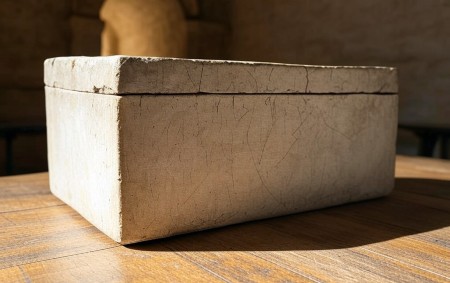We ask you, urgently: don’t scroll past this
Dear readers, Catholic Online was de-platformed by Shopify for our pro-life beliefs. They shut down our Catholic Online, Catholic Online School, Prayer Candles, and Catholic Online Learning Resources—essential faith tools serving over 1.4 million students and millions of families worldwide. Our founders, now in their 70's, just gave their entire life savings to protect this mission. But fewer than 2% of readers donate. If everyone gave just $5, the cost of a coffee, we could rebuild stronger and keep Catholic education free for all. Stand with us in faith. Thank you.Help Now >
Bone Box Inscribed with Name of Jesus' Brother Unveiled as 'Most Significant Relic from Time of Christ'
FREE Catholic Classes
A remarkable relic from the time of Jesus--an ancient bone box, or ossuary, inscribed with the name of Jesus' brother--has found its way to the United States, drawing both awe and controversy. This limestone box, discovered in Israel in 1976, carries the inscription "James, son of Joseph, brother of Jesus" in ancient Aramaic. Because the names inscribed correspond to those of Jesus' family, many scholars and theologians believe it once held the remains of James the Just, the first leader of the Christian community in Jerusalem after the crucifixion.

An AI-rendering of what James' ossuary could look like.
Highlights
12/20/2024 (1 week ago)
Published in Living Faith
Keywords: Jesus' brother, Ancient Bone Box, James
Currently displayed at Pullman Yards in Atlanta, Georgia, this ossuary is part of a larger exhibition that showcases 350 items from the time of Jesus. The exhibit has described the ossuary as "the most significant item from the time of Christ" due to its potential connection to the historical Jesus.
However, the discovery has not been without controversy. Following the ossuary's public unveiling in 2002, its authenticity was questioned, and the owner of the relic, Israeli antiquities collector Oded Golan, was accused of forging the inscription. Some experts alleged that the phrase "brother of Jesus" had been added later, making the ossuary a modern forgery. Golan spent years defending the artifact's authenticity in court, and after a ten-year trial, he was acquitted of all charges.
"I didn't recognize its importance at all," Golan admitted in a recent interview. He explained that he had purchased the ossuary when he was an engineering student in Israel, unaware of its significance. Despite his acquittal, the court's decision did not fully settle the matter. While the judge ruled in Golan's favor, the verdict also noted that it "does not mean that the inscription on the ossuary is authentic or that it was written 2,000 years ago."
Nevertheless, Golan has maintained that the inscription is genuine. "We conducted several chemical tests, particularly on the inscription itself, which is the most critical element of the ossuary," Golan told Crosswalk Headlines. "We proved that the entire inscription is authentic--it was engraved several thousand years ago." If true, the ossuary could represent the oldest physical evidence we have of Jesus, making it a groundbreaking artifact for both archaeologists and theologians.
The discovery has been further complicated by theological debates, particularly regarding the status of Jesus' family. Some theologians argue that Mary remained a perpetual virgin, which would cast doubt on the claim that James was Jesus' literal brother. According to these beliefs, the inscription might be interpreted differently, with some suggesting that James could have been a close relative or a spiritual brother rather than a biological one.
In the first century, Jews practiced a custom of laying their dead in caves, later gathering the bones to place in ossuaries. The James Ossuary is now empty, with the bones long lost, but the inscription remains as a tangible link to the past.
The New Testament mentions several brothers of Jesus, including James, Jude, Simon, and Joses. Notably, James is always listed first, implying his prominence among them. Scriptures such as Mark 3:21 indicate that James and Jesus' other brothers initially did not believe Jesus was the Messiah. The passage states, "When his family heard about this, they went to take charge of him, for they said, 'He is out of his mind.'" Despite this, James would later become one of the foremost leaders in the early Christian community.
James, also known as "James the Just," is said to have been martyred for his faith. According to early church historians, he was either stoned to death in 62 AD or thrown from the pinnacle of the Temple in Jerusalem by Jewish authorities before being clubbed to death. These acts of martyrdom were likely attempts to suppress the growing Christian movement in the wake of Christ's crucifixion.
In 2015, a study was conducted to determine whether the James Ossuary came from a tomb near Jerusalem's Old City that some researchers believe may have belonged to Jesus' family. This tomb, discovered in 1980, contained several ossuaries with names matching those of Jesus' relatives, including James. The chemical analysis of the James Ossuary found traces of signatures that matched those found on the ossuaries in the Talpiot tomb, further fueling speculation about the relic's origins.
In addition to the ossuary, another important artifact was found in 2017. A 1,600-year-old document known as the "First Apocalypse of James" describes Jesus passing on knowledge to James, referred to as his brother. This text is part of the Nag Hammadi library, a collection of early Christian writings from the 2nd to 6th centuries. While it is considered heretical by mainstream Christianity, the text sheds light on the early traditions and beliefs about James and his relationship to Jesus.
For Catholics, the James Ossuary offers a powerful connection to the historical figure of Jesus' brother and his early followers. Whether or not the artifact is truly authentic, it serves as a poignant reminder of the early Christian church and the enduring legacy of those who lived during the time of Christ.
As the debate over the ossuary's authenticity continues, one thing remains clear: the discovery of this bone box brings us closer to understanding the historical context of Jesus' life and the beginnings of Christianity. The mystery surrounding the "Jesus box" may never be fully resolved, but its place in history, real or imagined, is a testament to the ongoing search for evidence that links faith with history.
Join the Movement
When you sign up below, you don't just join an email list - you're joining an entire movement for Free world class Catholic education.

-

-
Mysteries of the Rosary
-
St. Faustina Kowalska
-
Litany of the Blessed Virgin Mary
-
Saint of the Day for Wednesday, Oct 4th, 2023
-
Popular Saints
-
St. Francis of Assisi
-
Bible
-
Female / Women Saints
-
7 Morning Prayers you need to get your day started with God
-
Litany of the Blessed Virgin Mary
The Deacon Saint Stephen the Proto-Martyr is a Model for all Christians
-

Love is Born on Christmas Morn, and the World is Born Anew
-

Rediscovering the True Importance of Christmas for Catholics
-
5 Ways to keep Jesus in your Christmas celebrations this year
-
Get your oven mitts ready, it's time to bake Christmas cookies!
Daily Catholic
 Daily Readings for Sunday, December 29, 2024
Daily Readings for Sunday, December 29, 2024 St. Aileran: Saint of the Day for Sunday, December 29, 2024
St. Aileran: Saint of the Day for Sunday, December 29, 2024 I Came to You Late: Prayer of the Day for Sunday, December 29, 2024
I Came to You Late: Prayer of the Day for Sunday, December 29, 2024- Daily Readings for Saturday, December 28, 2024
- St. Anthony the Hermit: Saint of the Day for Saturday, December 28, 2024
- Litany to the Sacred Head of Jesus: Prayer of the Day for Saturday, December 28, 2024
![]()
Copyright 2024 Catholic Online. All materials contained on this site, whether written, audible or visual are the exclusive property of Catholic Online and are protected under U.S. and International copyright laws, © Copyright 2024 Catholic Online. Any unauthorized use, without prior written consent of Catholic Online is strictly forbidden and prohibited.
Catholic Online is a Project of Your Catholic Voice Foundation, a Not-for-Profit Corporation. Your Catholic Voice Foundation has been granted a recognition of tax exemption under Section 501(c)(3) of the Internal Revenue Code. Federal Tax Identification Number: 81-0596847. Your gift is tax-deductible as allowed by law.






 Daily Readings for Sunday, December 29, 2024
Daily Readings for Sunday, December 29, 2024 St. Aileran: Saint of the Day for Sunday, December 29, 2024
St. Aileran: Saint of the Day for Sunday, December 29, 2024 I Came to You Late: Prayer of the Day for Sunday, December 29, 2024
I Came to You Late: Prayer of the Day for Sunday, December 29, 2024

